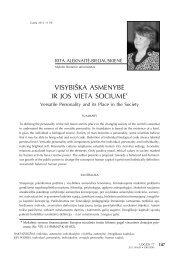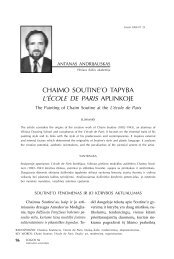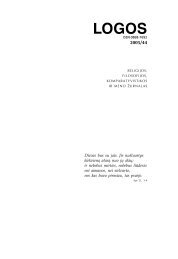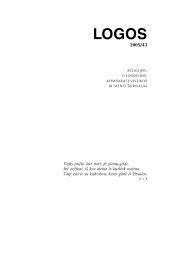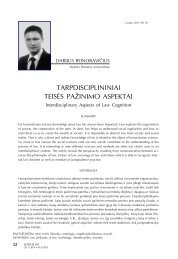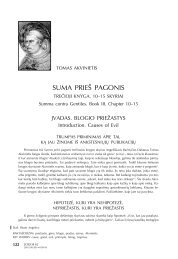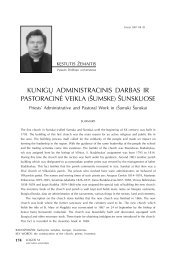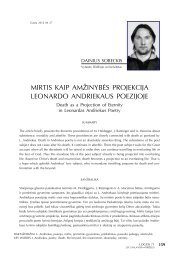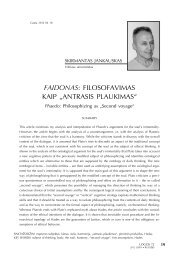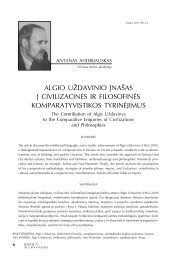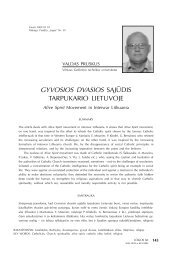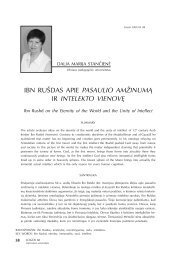Bet kvailas žmogus įgis supratimą, Kai laukinė a - Logos
Bet kvailas žmogus įgis supratimą, Kai laukinė a - Logos
Bet kvailas žmogus įgis supratimą, Kai laukinė a - Logos
Create successful ePaper yourself
Turn your PDF publications into a flip-book with our unique Google optimized e-Paper software.
EGIDIJUS MAÞINTAS<br />
TURINIO IR VAIZDO TRANSFORMACIJOS<br />
MUZIKINËJE-TEATRINËJE KULTÛROJE<br />
202 LOGOS 42<br />
2005 BALANDIS • BIRÞELIS<br />
EGIDIJUS MAÞINTAS<br />
Vilniaus pedagoginis universitetas<br />
Transformations of Content and Scene<br />
in Musical and Theatrical Culture<br />
SUMMARY<br />
Gauta 2005-03-12<br />
The teaching of rendering transformations of the content and scene of musical theatre, which is directed<br />
to the values of the performance, cannot be restricted to memorising or learning theatrical propositions<br />
or theoretical reasoning. In musical-theatrical culture, the fusion of content and image, be it<br />
visible or mental, reflects the perception of reality. The natural transformation of content, scene and<br />
sound happening in the viewer’s consciousness represents the reality perceived by producers. The syncretic<br />
nature of the art of antiquity, which has manifested itself in the unity of text, music, scene and<br />
dance, influenced the close connection of musical-theatrical European culture with philosophy, aesthetics,<br />
mathematics, physics and other branches of science, which influenced musical-theatrical<br />
Lithuanian culture. The explanations of the nature of content and scene were based on the works of<br />
Heraclitus, Pythagoras, Plato, Aristotle, Euclid. Transformations of the content and scene of musical<br />
theatres developed systematically into different directions, while orientating and adapting themselves to<br />
the cultures and civilisations of different centuries.<br />
Muzikiniame spektaklyje statytojø suformuotas<br />
turinys ir vaizdas susipina<br />
specifinëmis formomis ir tiesiogiai bei<br />
intuityviai veikia þiûrovus per jø suvokimo<br />
galimybiø prizmæ. Tad muzikinis<br />
spektaklis veikia þiûrovà ne tik formaliø<br />
estetiniø galimybiø visuma, bet ir skam-<br />
besio, groþio proporcijomis, sukelianèiomis<br />
þiûrovams skirtingas emocines reakcijas.<br />
Praþûtingas ir kartais kurioziðkas<br />
bûna turinio ir vaizdo atskyrimas teatro<br />
mene. G. Flaubert’as ir G. Bennas konstatavo,<br />
kad forma gimstanti ið idëjos, arba<br />
tikëjimas ir veiksmas yra tik forma.<br />
RAKTAÞODÞIAI. Teatras, vaidyba, prasmës kûrimas, turinio ir vaizdo transformacija.<br />
KEY WORDS. Theatre, production, construction of meaning, transformation of content and scene.



